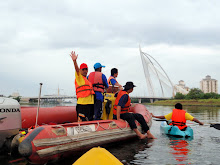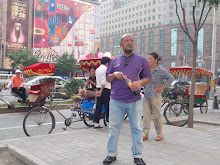KAYAK AT IPGM PERLIS
KAYAK AT TASIK PUTRAJAYA
KURSUS ASAS KAYAK
MASCA STAR ONE
TERMS CONTENTS
THEORY
HISTORY
1. HOW IT ALL BEGAN?
A] Kayak
B] Canoe
BASIC KNOWLEDGE, SAFETY & EQUIPMENT
1. The importance of proper clothing.
2. Introduction to equipment.
A] The boat
B] Paddle
C] Spray cover
D] Buoyancy aid / personal floating device [PFD]
E] Safety helmet
The difference between a Life Jacket and a Buoyancy Aid.
CONSTRUCTION
1. Parts of Kayak.
2. Parts of Paddle
SIGNALS
1Stop
1. Raft – Up
2. Moving Direction
3. Call – Off ( Return )
4. Emergency
PRACTICAL
SELF CONFIDENCE
1. Water Confidence
GOING AFLOAT
1. Carrying The Boat ;
a) Shoulder Level
b) Waist Level
2. Getting In ;
a) From A Low Bank
b) From a High Bank or Jetty
c) From Deep Water Level
COMING ASHORE
1. Getting Out
2. CapsizeDrill And Swim Ashore ;
a) Basic Drill
b) Emptying The Boat ( Bailing )
BASIC STROKE
1. Holding The Paddle
2. Forward Paddlling And Stop
3. Backward Paddling And Stop
SWEEPING STROKE
1. Forward Sweep
2. Backward Sweep
3. Alternate Combination Sweep ( 360 Turn )
STATIC STROKE
1. Draw
BALANCING EXERCISE
1. Rocking
2. Rafting
3. Gunnel Walk
4. Changing Seating Position
TERMS CONTENTS
THEORY
HISTORY
1. HOW IT ALL BEGAN?
A] Kayak
B] Canoe
BASIC KNOWLEDGE, SAFETY & EQUIPMENT
1. The importance of proper clothing.
2. Introduction to equipment.
A] The boat
B] Paddle
C] Spray cover
D] Buoyancy aid / personal floating device [PFD]
E] Safety helmet
The difference between a Life Jacket and a Buoyancy Aid.
CONSTRUCTION
1. Parts of Kayak.
2. Parts of Paddle
SIGNALS
1Stop
1. Raft – Up
2. Moving Direction
3. Call – Off ( Return )
4. Emergency
PRACTICAL
SELF CONFIDENCE
1. Water Confidence
GOING AFLOAT
1. Carrying The Boat ;
a) Shoulder Level
b) Waist Level
2. Getting In ;
a) From A Low Bank
b) From a High Bank or Jetty
c) From Deep Water Level
COMING ASHORE
1. Getting Out
2. CapsizeDrill And Swim Ashore ;
a) Basic Drill
b) Emptying The Boat ( Bailing )
BASIC STROKE
1. Holding The Paddle
2. Forward Paddlling And Stop
3. Backward Paddling And Stop
SWEEPING STROKE
1. Forward Sweep
2. Backward Sweep
3. Alternate Combination Sweep ( 360 Turn )
STATIC STROKE
1. Draw
BALANCING EXERCISE
1. Rocking
2. Rafting
3. Gunnel Walk
4. Changing Seating Position
MASCA TWO STAR – SUBJECT ( CONTENTS )
TERMS SUBJECT ( CONTENTS )
THEORY
EQUIPMENTS
a) The Boat
b) Paddle
c) Buoyancy Aid
d) Spray Cover
e) Safety Helmet
f) Throw Bag
g) Nose Clip
h) Knee Pad
i) Goggle
THREE ( 3 ) IMPORTANT PARTS OF KAYAK :
a) Deck
b) Hull
c) Cockpit
THREE ( 3 ) MOST COMMON TYPES OF HULL :
a) Mandesta - V Shape
b) Ottersport - U Shape ( flat bottom )
c) Slalom - U Shape ( rounded bottom )
CONSTRUCTION
a) Plastic
b) Fiberglass
c) Kevlar
a) Flat - Split Water
b) Curved - Less Cavitation
c) Asymetric - Helps To Exit
a) Holding The Paddle
b) Choosing The Paddle
a) Emergency Stop
b) Capsize Drill With Spray Cover Fitted And Swim Ashore
c) Swimming With Kayak
a) Low Paddling
b) High Paddling
Starboard and Port Side
a) Feathered Out Of Water
b) Feathered In Water
Starboard And Port side
Starboard And Port Side
a)Low Brace
b) High Brace
a) Low Recovery
b) High Recovery
a) Self Rescue
b) H Rescue And Re- Entry
c) H I Rescue And Re-Entry
d) Eskimo Paddle Rescue
e) Eskimo Bow Rescue
f) Pillon Carry
g) Stern Carry
a) Flick ( Hip )
- Using Bank
- Assisted ( Paddle / Hand )
- Vest
b) Slap Support - Long Shaft
c) Slap Support - Short Shaft
A] THEORY
1. History
1.1. How it all began ?
i] Kayak
ii] Canoe
2. Basic Knowledge, Safety & Equipment
2.1. The importance of proper clothing
2.2. Introduction to equipment
i] Kayak
ii] Paddle
iii] Spray Cover
iv] Buoyancy Aid / Personal Floating Device [PFD]
v] Safety Helmet
3. Construction
3.1. Parts of Kayak
3.2. Parts of Paddle
4. Signals
4.1. Stop
4.2. Raft Up
4.3. Moving Direction
4.4. Call Off [Return]
4.5. Ok
4.6. Emergency
B] PRACTICAL
1. Self Confidence
1.1. Water Confidence
2. Going Afloat
2.1. Carrying the Kayak
i] Shoulder Level
ii] Waist Level
2.2. Getting In From
i] Low Bank
ii] High Bank or Jetty
iii] Deep Water Level
3. Coming Ashore
i] Getting Out
ii] Capsize Drill & Swim Ashore
- Basic Drill
- Emptying Kayak [Bailing]
-
4. Basic Stroke
i] Holding the Paddle
ii] Forward Paddling & Stop
iii] Backward Paddling & Stop
5. Sweeping Stroke
i] Forward Sweep
ii] Backward Sweep
iii] Alternate Combination Sweep [360 degree turn]
6. Static Stroke
i] Draw
7. Balancing Exercise
i] Rocking
ii] Rafting
iii] Gunnel Walk
iv] Changing Seating Position
KAYAK STAR TWO
MASCA [Malaysia Canoe Association]
Learning Module
Duration : 3 days
Exam : Theory
: Practical on Single Kayaking
1.1. Kayak
1.2. Paddle
1.3. Buoyancy Aid
1.4. Spray Cover
1.5. Safety Helmet
1.6. Throw Bag
1.7. Nose Clip
1.8. Knee Pad
1.9. Goggle
2.1 Deck
2.2. Hull
2.3. Cockpit
4.2. Mandesta - V Shape
4.3. Ottersport - U Shape [flat bottom]
4.4. Slalom - U Shape [rounded bottom]
5.1. Plastic
5.2. Fiberglass
5.3. Kevlar
6. Three [3] Types & Designs of Paddle
6.1. Flat - Split Water
6.2. Curved - Less Cavitations
6.3. Asymmetric - Helps To Exit
7. Paddle Selection
7.1. Holding the Paddle
7.2. Choosing the Paddle
B] PRACTICAL
1. Basic Stroke :
Revision of Star One – Forward / Backward Stop, Draw, Sweep
8. Self Confidence
8.1. Emergency Stop
8.2. Capsize Drill with Spray Cover fitted and Swim Ashore
8.3. Swimming with Kayak
9. Forward Paddling
9.1. Low Paddling
9.2. High Paddling
10. Draw Stroke for Starboard & Port Side
10.1. Feathered Out of Water
10.2. Feathered In Water
11. Sculling Draw for Starboard & Port Side
12. Forward & Backward Sweep for Starboard & Port Side
13. Bracing [Telemark]
13.1. Low Brace
13.2. High Brace
14. Slap Support
14.1. Low Recovery
13.2. High Recovery
14. Rescues
14.1. Self Rescue
14.2. H Rescue & Re Entry
14.3. H I Rescue & Re Entry
14.4. Eskimo Paddle Rescue
14.5. Eskimo Bow Rescue
14.6. Pillon Carry
14.7. Stern Carry
11. Basic Rolling Techniques
11.1. Flick [Hip] using bank, paddle or hand assisted & vest
11.2. Slap Support - Long Shaft
11.3. Slap Support - Short Shaft




















